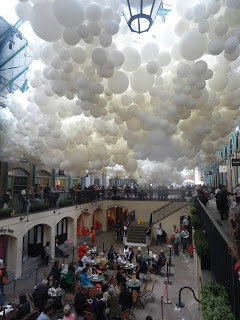Another very good exhibition of linocutting can be found at Osbourne Samuel.
This is a retrospective exhibition of the print works of Sybil Andrews. Sybil Andrews (1898-1992) had an interesting early life as a welder, and then art teacher, who next went on to become one of the leading lights of the Grosvenor School of Modern Art - a group of artists who taught art in day and evening classes at this private school from 1925 to 1940, and whose aim was to produce affordable art for the general public.
The Grosvenor School artists were strongly influenced by the artwork of the Futurists and Vorticists movements. They produced dynamic, graphic images based on speed - racing cars, speedway, fairground rides, the movement of machinery, men at work, and sports such as tennis and rowing. Music and religion were also strong themes in their prints.
These are wonderful stylised images and I was really surprised by how fresh, bright and vibrant the colours in these prints are considering their age. The prints are highly regarded and avidly collected, this is reflected in the prices they achieve, particularly Speedway, by Andrews below (£90,000 if you please!).
Towards the back of the gallery are a number of iconic prints by other members of the Grosvenor School such as Claude Flight and Cyril Power. There is also a lovely huge linocut by Edward Bawden (below), which complements beautifully the work of the Grosvenor School artists.
Sybil Andrews And The Grosvenor School Linocuts
until 10th October
Osborne Samuel
23a Bruton Street
London
www.osbornesamuel.com























































